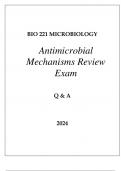Microbial mechanism Study guides, Class notes & Summaries
Looking for the best study guides, study notes and summaries about Microbial mechanism? On this page you'll find 737 study documents about Microbial mechanism.
Page 3 out of 737 results
Sort by
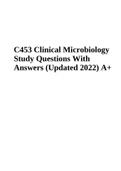
-
C453 Clinical Microbiology Study Questions With Answers (Updated 2022) A+
- Exam (elaborations) • 82 pages • 2022
- Available in package deal
-
- $8.49
- 1x sold
- + learn more
C453 Clinical Microbiology Study Questions With Answers (Updated 2022) A+. Describe the general characteristics of bacteria by answering the following questions. a. Are bacteria prokaryotic or eukaryotic? Why? Prokaryotic because their genetic material (DNA) is not housed within a true nucleus. b. Single-celled or multicellular? Why? Usually unicellular c. Can they be seen with the naked eye? Why? No; typically they are about 1um (need to be at least 100um to be visible without a microscope...
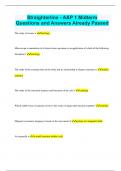
-
Straighterline - A&P 1 Midterm Questions and Answers Already Passed
- Exam (elaborations) • 24 pages • 2024
- Available in package deal
-
- $9.99
- + learn more
Straighterline - A&P 1 Midterm Questions and Answers Already Passed The study of tissues is histology Microscopic examination of a frozen tissue specimen is an application of which of the following disciplines? histology The study of the external form of the body and its relationship to deeper structures is surface anatomy The study of the structural features and functions of the cell is cytology Which subdivision of anatomy involves the study of organs that function together...
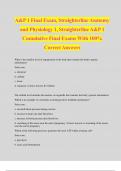
-
A&P 1 Final Exam, Straighterline Anatomy and Physiology 1, Straighterline A&P 1 Cumulative Final Exams With 100% Correct Answers
- Exam (elaborations) • 56 pages • 2024
-
- $14.49
- + learn more
A&P 1 Final Exam, Straighterline Anatomy and Physiology 1, Straighterline A&P 1 Cumulative Final Exams With 100% Correct Answers What is the smallest level of organization in the body that contains the body's genetic information? Select one: a. chemical b. cellular c. tissue d. organism -Correct Answer-B. Cellular The cellular level includes the nucleus, an organelle that contains the body's genetic information. Which is an example of a normally occurring positive-feedback mechanis...
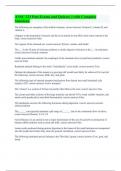
-
ANSC 223 Past Exams and Quizzes || with Complete Solutions.
- Exam (elaborations) • 19 pages • 2024
-
- $12.49
- + learn more
The following are examples of fat-soluble vitamins: correct answers Vitamin E, vitamin D, and vitamin A Changes in the proportion of muscle and fat in an animal do not affect total water content in the body. correct answers False The regions of the stomach are: correct answers Pyloric, cardiac, and fundic The___ in the GI tract of chickens performs a similar digestive function as the___ in ruminants. correct answers Gizzard, omasum Unlike non-ruminant animals, the esophagus in the ru...
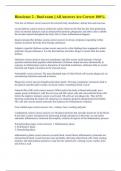
-
Bioscience 2 - final exam || All Answers Are Correct 100%.
- Exam (elaborations) • 25 pages • 2024
- Available in package deal
-
- $16.49
- + learn more
First line of defence correct answers the external body membranes -intract skin and mucosae. second defence correct answers called into action whenever the first line has been penetrated, relies on internal defences such as antimicrobial proteins, phagocytes and other cells to inhibit the invaders spread throughout the body, this is where inflammation happens. Innate (nonspecific) defense system correct answers Is always prepared, responding within minutes to protect the body from foreign ...
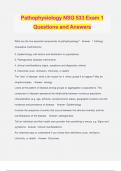
-
Pathophysiology NSG 533 Exam 1 Questions and Answers
- Exam (elaborations) • 27 pages • 2024
- Available in package deal
-
- $13.49
- + learn more
Pathophysiology NSG 533 Exam 1 Questions and Answers What are the five essential components of pathophysiology? - Answer- 1. Etiology (Causative mechanisms) 2. Epidemiology (risk factors and distribution in populations) 3. Pathogenesis (disease mechanism) 4. clinical manifestations (signs, symptoms and diagnostic criteria) 5. Outcomes (cure, remission, chronicity, or death) The "why" of disease- what is the reason for it- what caused it to happen? May be simple/complex. - Answer- etio...
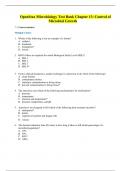
-
OpenStax Microbiology Test Bank Chapter 13: Control of Microbial Growth
- Exam (elaborations) • 13 pages • 2024
- Available in package deal
-
- $12.50
- + learn more
OpenStax Microbiology Test Bank Chapter 13: Control of Microbial Growth * = Correct answer Multiple Choice 1. Which of the following is not an example of a fomite? A. catheter B. doorknob C. mosquitoes* D. towels 2. HEPA filters are required for which Biological Safety Level (BSL)? A. BSL 1 B. BSL 2 C. BSL 3 D. BSL 4* 3. From a clinical perspective, aseptic technique is carried out to do which of the following? A. clean fomites B. contaminate fomites C. introduce co...
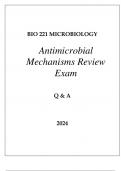
-
BIO 221 ANTIMICROBIAL MECHANISMS REVIEW EXAM Q & A 2024.
- Case • 19 pages • 2024
-
- $17.99
- + learn more
BIO 221 ANTIMICROBIAL MECHANISMS REVIEW EXAM Q & A 2024.BIO 221 ANTIMICROBIAL MECHANISMS REBIO 221 ANTIMICROBIAL MECHANISMS REVIEW EXAM Q & A 2024.BIO 221 ANTIMICROBIAL MECHANISMS REVIEW EXAM Q & A 2024.VIEW EXAM Q & A 2024.
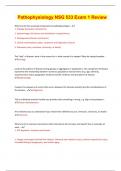
-
Pathophysiology NSG 533 Exam 1 Review 2024 Graded A+
- Exam (elaborations) • 20 pages • 2024
-
- $12.49
- + learn more
What are the five essential components of pathophysiology? - 1. Etiology (Causative mechanisms) 2. Epidemiology (risk factors and distribution in populations) 3. Pathogenesis (disease mechanism) 4. clinical manifestations (signs, symptoms and diagnostic criteria) 5. Outcomes (cure, remission, chronicity, or death) The "why" of disease- what is the reason for it- what caused it to happen? May be simple/complex. - etiology Looks at the pattern of disease among groups or aggregates or po...
BIO 221 ANTIMICROBIAL MECHANISMS REVIEW EXAM Q & A 2024.BIO 221 ANTIMICROBIAL MECHANISMS REVIEW EXAM Q & A 2024.BIO 221 ANTIMICROBIAL MECHANISMS REVIEW EXAM Q & A 2024.

Did you know that on average a seller on Stuvia earns $82 per month selling study resources? Hmm, hint, hint. Discover all about earning on Stuvia



